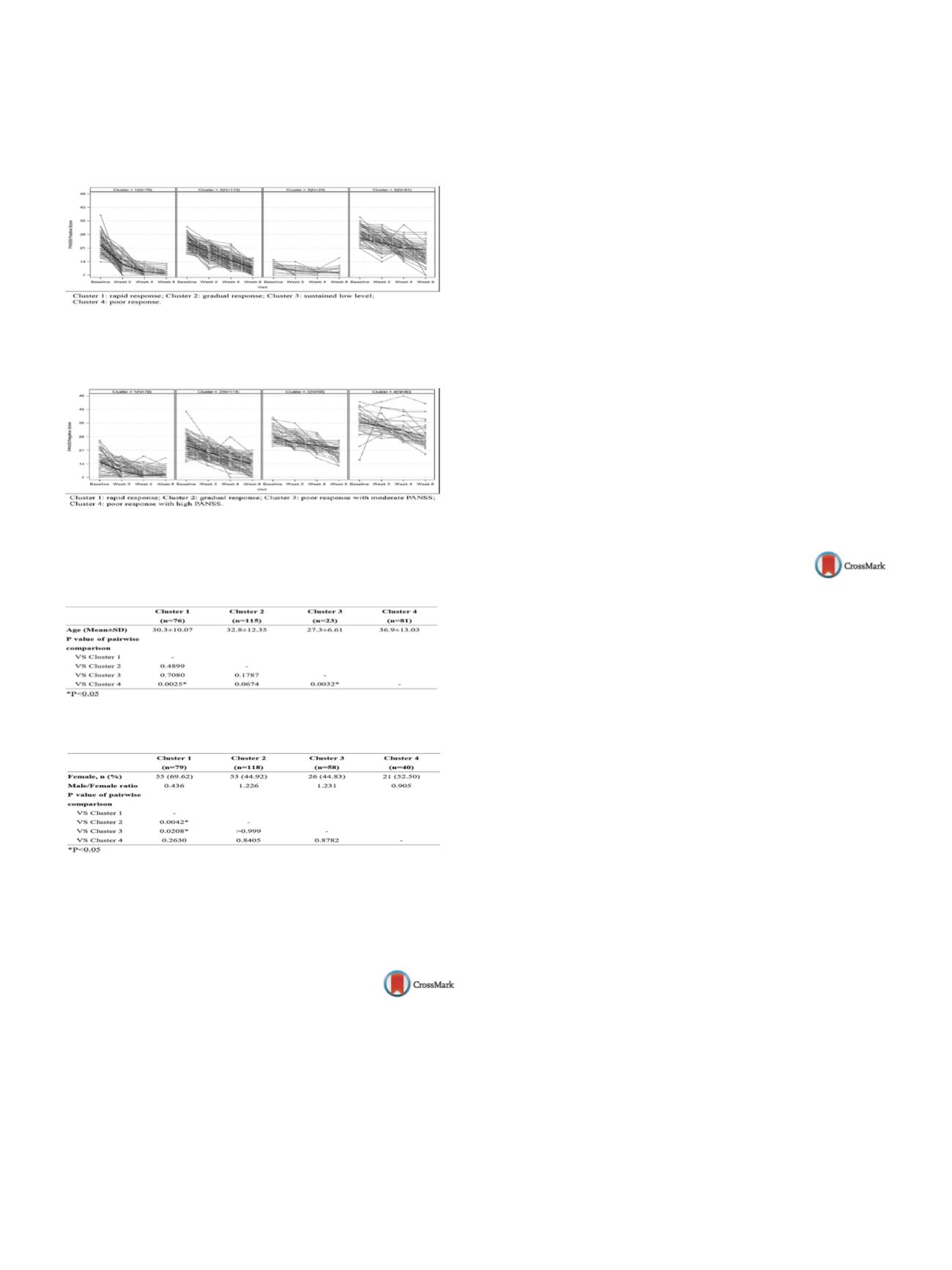

S820
25th European Congress of Psychiatry / European Psychiatry 41S (2017) S772–S846
cluster 1 was significantly lower than that in cluster 2 and cluster
3
( Table 2 , P= 0.0042 and 0.0208, respectively).
Conclusion
For the first time, we obtained effectiveness patterns
of amisulpride-treated Chinese patients. Age and gender may be
predictors of effectiveness.
Fig. 1
Time series clustering of PANSS positive score. Four clusters
and fitting curves (thick lines) are presented.
Fig. 2
Time series clustering of PANSS negative score. Four clus-
ters and fitting curves (thick lines) are presented.
Table 1
Age comparison of positive PANSS clusters.
Table 2
Gender comparison of negative PANSS clusters.
Disclosure of interest
This study is being funded by Sanofi (China)
Investment Co., Ltd.
http://dx.doi.org/10.1016/j.eurpsy.2017.01.1597EV1268
Treatment of drug-resistant
schizoaffective disorder with
aripiprazol depot off-label: A case
report
L. Niell Galmés
∗
, R.A. Baena Mures , Í. Alberdi Páramo ,
M.M. Tenorio Guadalupe , G. Montero Hernández ,
J. Rodríguez Quijano , L. Gallego Deike , A. Carrillo Gómez
Hospital Clínico San Carlos, psychiatry, Madrid, Spain
∗
Corresponding author.
Introduction
We expose a woman diagnosed with schizoaffec-
tive disorder 2 years ago, before she received several diagnostics.
She was admitted to the psychiatry unit with hyperactivity, pres-
sured speech without taking an appropriate turn, flight-of-ideas,
irritability, expansiveness, emotional liability, ideas of reference
and insomnia without diurnal tiredness. In addition, she admit-
ted having abandoned the medication one month ago. She was
diagnosed with maniac episode with psychotic symptoms and the
medication was reintroduced. After two weeks, no response was
observed so we decided to introduce ability depot 600mg/3 weeks.
Objectives
We want to show that is possible the use of ability
depot off-label in patients with a special difficulty in handling.
Also, we want to show that higher doses are not dangerous and
it’s possible to study new treatment guidelines for ability depot.
Methods
We use the Positive and Negative Syndrome Scale
(PANSS) pre (the day of the introduction) and post (at two weeks)
treatment with aripiprazol depot; the Clinical Global Impression
rating scale (CGI), also pre and post.
Results
We have obtained a punctuation of 180 in PANSS the day
of the introduction of the aripiprazol depot and 45 at two weeks.
In addition, we obtained 6 in CGI the day of the introduction and 3
at two weeks.
Conclusions
In this case, aripiprazol depot has shown good toler-
ability and efficacy for the acute phase of schizoaffective disorder at
higher doses than recommended in clinical guidelines. The efficacy
and safety data are consistent with short-term, placebo-controlled
studies of aripiprazol depot conducted in similar populations.
Disclosure of interest
The authors have not supplied their decla-
ration of competing interest.
http://dx.doi.org/10.1016/j.eurpsy.2017.01.1598EV1269
Clinical-immunological predictors of
prognosis of the efficiency of
antipsychotic therapy with
amisulpride in schizophrenia
O. Lobacheva
1 ,∗
, E. Kornetova
2, V. Nikitina
1, T. Vetlugina
1,
A. Semke
3 , L. Rakhmazova
41
Mental Health Research Institute, Tomsk National Research Medical
Center, Russian Academy of Sciences, Department of
Psychoneuroimmunology and Neurobiology, Tomsk, Russia
2
Mental Health Research Institute, Tomsk National Research Medical
Center, Russian Academy of Sciences, Endogenous Disorders
Department, Tomsk, Russia
3
Mental Health Research Institute, Tomsk National Research Medical
Center, Russian Academy of Sciences, Administration, Tomsk, Russia
4
Mental Health Research Institute, Tomsk National Research Medical
Center, Russian Academy of Sciences, Addictive States Department,
Tomsk, Russia
∗
Corresponding author.
Introduction
Detection of clinical-biological predictors of the
efficiency of antipsychotic therapy in schizophrenic patients,
correction and individualization of therapeutic indication of
antipsychotics are relevant questions of modern psychiatry.
Immune dysfunctions, disturbance of psychoneuroimmunological
interaction, metabolic imbalanceworsen clinical pattern of disease,
contribute to formation of therapeutic resistance and side effects,
and decrease efficiency of treatment of patients.
Objective
To detect clinical-immunological predictors of the effi-
ciency of therapy of schizophrenic patients with amisulpride.
Methods
We examined 19 schizophrenic patients, aged 18–64
years, who received treatment with amisulpride (Solian). The
psychometric scale PANSS was used for evaluation of dynamics
of psychopathological symptoms. Therapy efficiency was evalu-
ated using CGI scale. The immunological investigation included
identification of phenotypes of surface receptors of immuno-
competent cells, level of IgM, IgG, IgA, phagocytic activity of
leucocytes. Research was carried out in two points: first–at admis-
sion, second–by week 6 of treatment. Predictors of efficiency were
identified relying on the analysis of interquartile ranges of clinical-
immunological parameters.


















